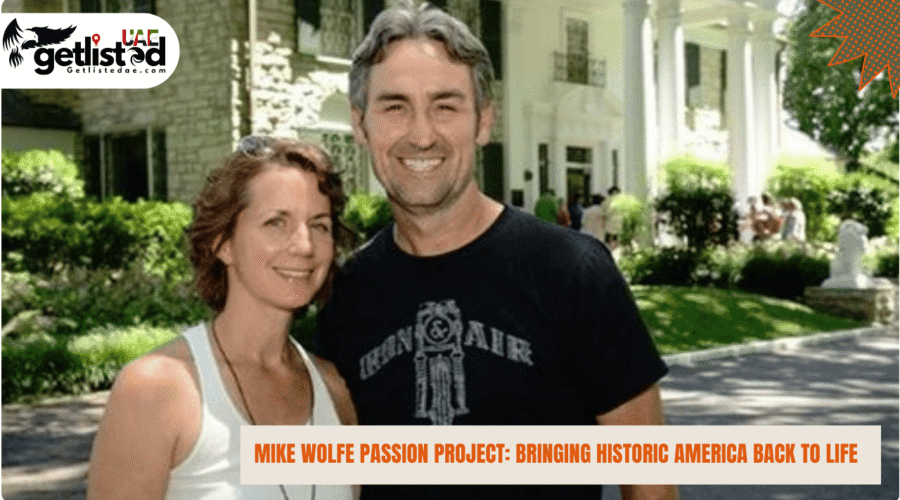Mike Wolfe Passion Project: How the American Pickers Star is Transforming Historic Preservation
Mike Wolfe has become a household name through his hit television show American Pickers, but his most meaningful work extends far beyond the cameras. The Mike Wolfe passion project represents a transformative approach to historic preservation that’s revitalizing small-town America one building at a time. This comprehensive guide explores how Wolfe’s dedication to restoration is creating lasting change in communities across the United States.
What is the Mike Wolfe Passion Project?
The Mike Wolfe passion project is an ambitious preservation initiative that combines historic restoration with community development. Unlike traditional antique collecting, this project focuses on saving entire buildings and structures that tell the story of American heritage.
Wolfe’s approach goes beyond simple renovation. He carefully restores historical properties while maintaining their authentic character, then repurposes them as functional spaces that serve local communities. This method creates a sustainable model for preservation that benefits both history and modern society.
Core Elements of Mike Wolfe Passion Project
The passion project encompasses several key components:
- Historic building acquisition and restoration
- Community engagement and development
- Support for local artisans and craftspeople
- Educational storytelling and preservation awareness
- Sustainable restoration practices
From TV Personality to Preservation Pioneer
Mike Wolfe Passion Project journey from television star to preservation advocate began during his travels for American Pickers. As he explored forgotten corners of America, he witnessed countless historic buildings falling into disrepair or facing demolition. This experience sparked a realization that the real treasures weren’t just the objects inside these buildings—they were the structures themselves.
The transition from picker to preservationist wasn’t sudden. Wolfe gradually recognized that saving individual antiques meant little if the historical context surrounding them disappeared forever. This understanding became the foundation of his passion project philosophy.
The Evolution of His Mission
Initially focused on finding unique items for collectors, Wolfe’s mission evolved to encompass broader preservation goals. He began seeing patterns in his travels: small towns losing their identity, historic Main Streets becoming ghost towns, and irreplaceable architecture being lost to neglect or development pressure.
This shift in perspective transformed how Wolfe approached his work. Instead of simply removing artifacts from their historical context, he began investing in preserving the context itself.
Columbia, Tennessee: The Heart of Restoration
Columbia, Tennessee serves as the primary location for Mike Wolfe’s passion project. This charming Southern town captured Wolfe’s attention with its collection of well-preserved 19th and early 20th-century architecture, much of which was at risk of deterioration.
Wolfe’s investment in Columbia began with the purchase of several key properties on the town’s historic Main Street. His restoration work has since expanded to include multiple buildings, each carefully renovated to maintain historical integrity while serving modern purposes.
Transforming Main Street
The impact of Wolfe’s work in Columbia extends beyond individual buildings. His restoration efforts have:
- Sparked local business development
- Increased tourism to the area
- Encouraged other property owners to invest in preservation
- Created jobs in construction, hospitality, and retail
- Enhanced community pride and identity
The transformation of Columbia demonstrates how strategic preservation can revitalize entire downtown areas. Wolfe’s success here has become a model for similar efforts in other small towns across America.
Community Partnership and Engagement of Mike Wolfe Passion Project
Wolfe’s approach in Columbia emphasizes collaboration with local residents, business owners, and government officials. Rather than imposing his vision from the outside, he works to understand community needs and incorporate local input into his restoration plans.
This partnership model ensures that restored buildings serve genuine community purposes rather than becoming empty showcases. The result is a more authentic and sustainable preservation effort that benefits everyone involved.
The Restoration Philosophy Behind the Mike Wolfe Passion Project
The Mike Wolfe passion project operates on a distinct restoration philosophy that prioritizes authenticity, sustainability, and community benefit. This approach differs significantly from conventional development or even some traditional preservation methods.
Preserving Authentic Character
Wolfe’s restoration work focuses intensively on maintaining the authentic character of historic buildings. This means:
- Preserving original architectural elements whenever possible
- Using period-appropriate materials and techniques
- Maintaining historical color schemes and design patterns
- Protecting weathered surfaces that tell the building’s story
- Integrating modern amenities without compromising historical integrity
Adaptive Reuse Strategy
Rather than creating museum pieces, Wolfe transforms historic buildings into functional spaces that serve contemporary needs. This adaptive reuse strategy ensures that preserved buildings remain vibrant parts of their communities rather than static historical displays.
Examples of successful adaptive reuse include converting old storefronts into artisan workshops, transforming unused upper floors into creative studios, and repurposing warehouse spaces for community events and markets.
Supporting American Artisans and Craftspeople
A crucial component of the Mike Wolfe passion project involves supporting American makers, artisans, and traditional craftspeople. Wolfe recognizes that preserving buildings means little without also preserving the skills and knowledge needed to maintain them properly.
Collaboration with Traditional Craftspeople
Wolfe actively seeks partnerships with craftspeople who specialize in traditional building techniques. These collaborations serve multiple purposes:
- Ensuring authentic restoration methods
- Preserving traditional skills and knowledge
- Creating opportunities for skilled craftspeople
- Educating younger generations about traditional techniques
- Building networks of preservation professionals
Showcasing Local Talent
The restored spaces often serve as galleries and workshops for local artisans. This creates economic opportunities for creative professionals while maintaining the connection between preserved buildings and ongoing creative traditions.
By providing platforms for local makers, Wolfe ensures that his preservation efforts support living culture rather than simply maintaining empty historical shells.
Sustainable Preservation Practices
Environmental sustainability plays a significant role in the Mike Wolfe passion project. Wolfe’s team employs restoration methods that minimize environmental impact while maximizing the reuse of existing materials.
Material Reuse and Recycling
Historic restoration naturally involves substantial material reuse, but Wolfe takes this practice further by:
- Salvaging materials from buildings that cannot be saved
- Incorporating reclaimed elements into new restoration projects
- Using locally sourced materials when replacement is necessary
- Employing traditional techniques that have lower environmental impact
Energy Efficiency Improvements
While maintaining historical character, Wolfe’s restorations often include modern energy efficiency improvements. These upgrades reduce long-term operating costs while making historic buildings more practical for contemporary use.
Careful integration of insulation, updated electrical systems, and efficient heating and cooling helps ensure that preserved buildings remain economically viable for decades to come.
Educational Impact and Storytelling of Mike Wolfe Passion Project
Education represents a fundamental aspect of the Mike Wolfe passion project. Wolfe uses his platform and restored spaces to teach others about preservation techniques, architectural history, and the importance of maintaining America’s built heritage.
Sharing the Journey
Through social media, interviews, and public appearances, Wolfe documents the restoration process from beginning to end. These educational materials help others understand:
- The challenges involved in historic preservation
- The techniques required for authentic restoration
- The economic and social benefits of preservation
- The stories behind historic buildings and their communities
Inspiring Others to Act
By sharing both successes and challenges, Wolfe demonstrates that preservation is achievable for individuals and communities with dedication and proper planning. His transparency about costs, timelines, and obstacles helps others make informed decisions about their own preservation projects.
Economic Impact of Historic Preservation
The Mike Wolfe passion project demonstrates the significant economic benefits that thoughtful historic preservation can bring to small communities. These benefits extend far beyond the immediate construction jobs created during restoration.
Tourism and Cultural Heritage
Wolfe’s restoration efforts in Columbia have created new tourist attractions that draw visitors interested in American history, architecture, and antiques. This increased tourism provides economic benefits for:
- Local restaurants and cafes
- Bed and breakfasts and hotels
- Other antique shops and boutiques
- Tour guides and cultural organizations
Property Value Enhancement
Historic preservation typically increases property values throughout the surrounding area. Wolfe’s work in Columbia has contributed to rising real estate values and increased investment in other downtown properties.
Job Creation and Skill Development
The restoration projects create employment opportunities in various fields:
- Construction and traditional building trades
- Architectural preservation specialists
- Artisans and craftspeople
- Tourism and hospitality workers
- Retail and small business entrepreneurs
Challenges and Solutions in Historic Preservation
The Mike Wolfe passion project has encountered numerous obstacles common to historic preservation efforts. Understanding these challenges and Wolfe’s approaches to solving them provides valuable insights for other preservation advocates.
Regulatory and Legal Hurdles
Historic preservation often involves navigating complex regulatory environments, including:
- Local zoning restrictions
- Historic preservation guidelines
- Building codes and safety requirements
- Permit processes and approvals
Wolfe’s success stems partly from his willingness to work patiently within these systems while advocating for reasonable accommodations that serve both preservation and safety goals.
Financial Considerations
Historic restoration typically costs more than new construction, creating financial challenges that Wolfe addresses through:
- Careful project planning and budgeting
- Phased restoration approaches
- Creative financing solutions
- Partnership with local investors and organizations
Technical Restoration Challenges
Old buildings present unique technical challenges that require specialized knowledge and skills. Wolfe’s team has developed expertise in addressing common issues such as:
- Structural problems in aging buildings
- Lead paint and asbestos remediation
- Updating electrical and plumbing systems
- Improving insulation and energy efficiency
- Addressing water damage and foundation issues
The Broader Historic Preservation Movement
Mike Wolfe’s individual efforts contribute to a larger movement of historic preservation happening across America. Understanding this broader context helps illustrate the significance of his passion project.
National Trends in Preservation
Historic preservation has gained momentum nationwide as communities recognize the value of maintaining their architectural heritage. Trends supporting this movement include:
- Increased awareness of environmental benefits
- Growing interest in authentic cultural experiences
- Recognition of economic development potential
- Support for sustainable development practices
Policy and Advocacy
Wolfe uses his platform to advocate for preservation-friendly policies at local, state, and national levels. His visibility as a television personality gives him unique opportunities to influence public opinion and policy decisions affecting historic preservation.
Technology and Innovation in Restoration
The Mike Wolfe passion project incorporates modern technology to enhance traditional restoration techniques. This combination of old and new approaches creates more effective and accurate preservation results.
Documentation and Research
Modern technology aids in documenting buildings before, during, and after restoration:
- 3D scanning and modeling
- Detailed photographic records
- Historical research using digital archives
- Structural analysis using advanced tools
Precision Restoration Techniques
Technology also enables more precise restoration work:
- Spectral analysis to match original paint colors
- Computer-aided design for replacement elements
- Non-destructive testing to assess structural integrity
- Digital archives of architectural details and measurements
Community Building Through Preservation
Beyond the physical restoration work, the Mike Wolfe passion project emphasizes community building and social connection. Restored buildings become gathering places that strengthen community bonds and create new opportunities for social interaction.
Creating Third Places
Sociologists describe “third places” as social spaces that exist between home and work—places where community members can gather informally. Wolfe’s restored buildings often serve this function, providing venues for:
- Community meetings and events
- Local art exhibitions and performances
- Educational workshops and classes
- Social gatherings and celebrations
Intergenerational Connection
The preservation work creates opportunities for older and younger community members to connect over shared appreciation for local history. Elderly residents often contribute stories and memories about buildings, while younger people bring energy and new perspectives to preservation efforts.
Future Expansion and Vision of Mike Wolfe Passion Project
The Mike Wolfe passion project continues to evolve and expand. Wolfe’s future plans include extending his preservation work to additional communities while developing new approaches to education and advocacy.
Geographic Expansion
While Columbia, Tennessee remains the primary focus, Wolfe has expressed interest in applying his preservation model to other small towns facing similar challenges. This expansion would help demonstrate the replicability of his approach while addressing preservation needs in additional communities.
Educational Programming
Future developments may include:
- Documentary projects focusing on preservation techniques
- Educational partnerships with schools and universities
- Workshops and training programs for aspiring preservationists
- Online resources and guides for community preservation efforts
Advocacy and Policy Work
Wolfe continues to use his platform to advocate for policies that support historic preservation, including:
- Tax incentives for preservation projects
- Streamlined permitting processes
- Funding opportunities for small-town preservation
- Education about the benefits of preservation over demolition
Lessons for Aspiring Preservationists
The Mike Wolfe passion project offers valuable lessons for individuals and communities interested in historic preservation:
Start Small and Build Momentum
Wolfe’s success demonstrates the value of starting with manageable projects and building credibility through successful completion. Early successes create momentum that makes larger projects more feasible.
Engage the Community
Successful preservation requires community buy-in and participation. Wolfe’s emphasis on community engagement ensures that his projects serve real needs and maintain long-term support.
Balance Authenticity with Functionality
Effective historic preservation must balance respect for historical authenticity with practical functionality for contemporary use. Wolfe’s projects succeed because they serve real community needs while maintaining historical character.
Think Long-Term
Preservation is a long-term endeavor that requires patience, persistence, and sustained commitment. Wolfe’s success stems from his willingness to take on complex, multi-year projects that deliver lasting benefits.
The Cultural Impact of Preservation
The Mike Wolfe passion project contributes to broader cultural preservation efforts that maintain America’s diverse architectural and social heritage. This work helps communities maintain their unique identities in an increasingly homogenized world.
Preserving Local Identity
In an era of chain stores and generic development, preserved historic buildings help communities maintain their distinctive character and sense of place. Wolfe’s work demonstrates how preservation can serve as an antidote to cultural homogenization.
Connecting Past and Present
Historic buildings serve as tangible connections between past and present, helping current residents understand their community’s history and development. Wolfe’s storytelling approach ensures that these connections remain strong and meaningful.
Measuring Success and Impact of Mike Wolfe Passion Project
The success of the Mike Wolfe passion project can be measured through various metrics that demonstrate its comprehensive impact on communities and preservation efforts.
Economic Indicators
- Increased property values in restoration areas
- New business development and job creation
- Tourism revenue and visitor numbers
- Investment in additional preservation projects
Social and Cultural Metrics
- Community engagement in preservation activities
- Educational program participation
- Media coverage and public awareness
- Policy changes supporting preservation
Preservation Outcomes
- Number of buildings saved from demolition
- Square footage of space restored and returned to use
- Historical features preserved and documented
- Traditional skills and knowledge transferred
Conclusion: A Legacy Built on Preservation
The Mike Wolfe passion project represents more than just a series of restoration projects—it embodies a comprehensive approach to community revitalization through historic preservation. Wolfe’s work demonstrates that preserving the past can create vibrant, economically viable communities for the future.
His success in Columbia, Tennessee, and his growing influence on the broader preservation movement show that individual passion and commitment can create significant positive change. The project serves as both an inspiration and a practical model for communities seeking to balance development with historic preservation.
As America continues to grapple with questions about growth, sustainability, and community identity, the Mike Wolfe passion project offers a compelling vision of how preservation can address multiple challenges simultaneously. By saving buildings, supporting communities, and celebrating craftsmanship, Wolfe has created a legacy that extends far beyond television entertainment.
The future of the Mike Wolfe passion project looks bright, with expansion plans and continued community impact on the horizon. For anyone interested in historic preservation, community development, or sustainable tourism, Wolfe’s work provides a roadmap for creating meaningful change through dedicated commitment to preserving America’s architectural heritage.
Whether you’re a longtime American Pickers fan or someone newly interested in historic preservation, the Mike Wolfe passion project demonstrates the powerful impact that passionate individuals can have on their communities. Through careful restoration, thoughtful community engagement, and unwavering commitment to authenticity, Wolfe continues to prove that the past and future can work together to create something truly special.
This ongoing project reminds us that historic preservation isn’t just about maintaining old buildings—it’s about maintaining the stories, skills, and sense of place that make communities unique. In an increasingly connected but often impersonal world, the Mike Wolfe passion project offers a model for creating meaningful connections between people, places, and the rich history that surrounds us all.
Frequently Asked Questions about Mike Wolfe Passion Project
1. What exactly is Mike Wolfe’s passion project?
Mike Wolfe’s passion project is a historic preservation initiative focused on buying, restoring, and repurposing old buildings in small-town America. Rather than just collecting antiques, Wolfe saves entire structures and transforms them into functional community spaces while maintaining their historical character.
2. Where is Mike Wolfe doing most of his restoration work?
The primary location for Wolfe’s passion project is Columbia, Tennessee, where he has purchased and restored multiple historic buildings along Main Street. This small Southern town serves as the heart of his preservation efforts and community revitalization work.
3. How did Mike Wolfe transition from American Pickers to preservation?
While traveling for American Pickers, Wolfe noticed countless historic buildings falling into disrepair or facing demolition. He realized that saving individual antiques meant little if the historical context around them disappeared, leading him to focus on preserving entire structures and their stories.
4. What types of buildings does Mike Wolfe restore?
Wolfe typically focuses on historic commercial buildings, storefronts, and homes from the 19th and early 20th centuries. He looks for properties with architectural significance that can be restored and repurposed for modern community use while maintaining their authentic character.
5. How does Mike Wolfe fund his restoration projects?
While specific funding details aren’t publicly disclosed, Wolfe’s restoration work appears to be funded through his American Pickers success, strategic partnerships, and the revenue generated from restored properties that house retail spaces and community venues.
6. Does Mike Wolfe work with local communities on his projects?
Yes, community engagement is central to Wolfe’s approach. He collaborates with local residents, business owners, artisans, and government officials to ensure restored buildings serve genuine community needs rather than becoming isolated showcases.
7. What makes Mike Wolfe’s restoration approach different from others?
Wolfe’s approach emphasizes preserving authentic character over modern aesthetics, supporting local artisans and craftspeople, and creating functional spaces that serve community needs. He focuses on adaptive reuse rather than turning buildings into static museum pieces.
8. Can people visit Mike Wolfe’s restored buildings?
Many of Wolfe’s restored buildings in Columbia, Tennessee, are open to the public as they house retail spaces, galleries, and community venues. These spaces showcase both the restoration work and the local artisans and creators he supports.
9. Is Mike Wolfe planning to expand his preservation work to other towns?
While Columbia, Tennessee remains his primary focus, Wolfe has expressed interest in applying his preservation model to other small towns facing similar challenges. Future expansion would help demonstrate the replicability of his community-focused approach.
10. How can someone get involved in historic preservation like Mike Wolfe?
Interested individuals can start by researching local historic buildings, connecting with preservation organizations, learning about traditional building techniques, and engaging with their local communities. Wolfe’s work shows that preservation begins with recognizing the value of existing structures and taking action to protect them.





